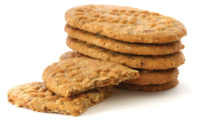Building ‘better-for-you’ into snacks and baked goods

The concept of “better-for-you” products continues to grip the food industry, and the snack and bakery market is no exception. Part of the appeal is its flexibility. Better-for-you, as a product concept, can include a wide-ranging list of formulation tactics. As we see in the 2017 Snack Food & Wholesale Bakery “State of the Industry—Bakery” analysis in our upcoming June issue, better-for-you manifests itself through natural, clean-label, organic, non-GMO, gluten-free and free-from, as well as through nutritional improvements like selection of improved fats and oils, added protein, fiber fortification, use of whole and diverse grains, added nutritional ingredients like nuts and seeds, and so on.
In order to learn more about how snack producers and bakers can build more better-for-you attributes into their products—including perspectives on flavor—we recently reached out to the team at Wixon, St. Francis, WI, including Jamie Smith, food scientist; AnnMarie Kraszewski, lab manager; and Roni Eckert, senior food scientist.
Douglas J. Peckenpaugh: How do you define “better-for-you” when it comes to snack and bakery products?
Jamie Smith: Products with a health-halo would be considered “better-for-you.” For snack and bakery, that includes products formulated with lower sugar, salt, and fat content, as well as products containing healthful ingredients, such as whole grains, pulses, legumes, seeds, fruits and vegetables. Higher protein and fiber remain key drivers of better-for-you. Foods that are less processed and contain no artificial ingredients also fit into many consumers’ definition of better-for-you.
DJP: What is driving the demand for these foods?
 AnnMarie Kraszewski: Consumers are more aware of what’s in their food, and want to be more informed on their food choices. They are more knowledgeable about ingredients and their impact on the nutritional value of the foods they consume. Simple, real food ingredients, along with natural and non-GMO, are now common label claims and requirements.
AnnMarie Kraszewski: Consumers are more aware of what’s in their food, and want to be more informed on their food choices. They are more knowledgeable about ingredients and their impact on the nutritional value of the foods they consume. Simple, real food ingredients, along with natural and non-GMO, are now common label claims and requirements.
DJP: Which types of snacks and baked goods are strong candidates for nutritional improvements?
AK: Salty snacks are great candidates, since options for the base product are vast. Vegetables, fruits, whole and ancient grain combinations, and legumes/pulses along with the right seasoning blends, can result in highly desirable, better-for you products.
Roni Eckert: A better-for-you handheld snack can serve as a convenient mini-meal. There are a variety of dough formats and fillings that can be used to create these types of products. Ancient grain flours such as amaranth, millet and buckwheat; whole grains and whole-grain flour; garbanzo bean flour; and pea protein are some ingredient choices for better-for-you doughs and various baked goods.
DJP: How does the flavor profile of a snack product or baked good impact its perception as healthy vs. indulgent?
AK: Flavor is important to consumers, and using more healthful ingredients may require the use of different kinds of flavors and seasonings. Many healthful ingredients bring inherent tastes along with the health-halo. The key is to identify complementary flavors and seasoning blends to pair with new ingredients while delivering the great taste that consumers expect for the given product application. Using real food ingredients to impart flavor is a great option. Spices like turmeric, rosemary and cinnamon, and ingredients such as tea powders and protein, can provide the consumer with great flavor, while at the same time delivering a healthy and enjoyable eating experience.
Looking for a reprint of this article?
From high-res PDFs to custom plaques, order your copy today!






